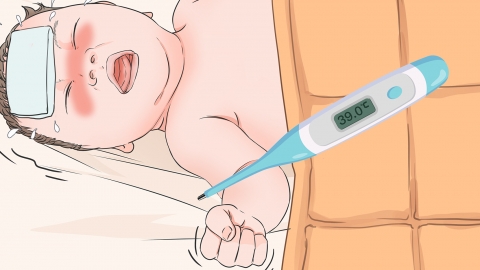How to improve when a baby has a fever and red eyes
Generally speaking, fever refers to an elevated body temperature. A baby having a fever with red eyes may be caused by factors such as thermoregulation mechanisms, eye fatigue, conjunctivitis, keratitis, Kawasaki disease, and others. Improvement can be achieved through general treatments, medications, and other methods under a doctor's guidance. Detailed explanations are as follows:

1. Thermoregulation Mechanism
During the process of body temperature regulation, elevated body temperature and accelerated blood circulation may lead to dilation of blood vessels in the eyes, causing them to appear red. It is important to maintain a suitable ambient temperature for the baby, avoid excessive bundling that may raise body temperature, and appropriately adjust clothing according to changes in the external environment.
2. Eye Fatigue
Extended periods of focusing on objects or insufficient sleep can cause eye muscle fatigue and poor circulation, resulting in red eyes. Ensure the baby gets sufficient sleep, avoid prolonged screen time or staring at toys, and encourage regular eye rest, such as closing the eyes or looking into the distance.
3. Conjunctivitis
Conjunctivitis is caused by infections from bacteria, viruses, or chlamydia. These pathogens may cause conjunctival congestion, resulting in red eyes, along with symptoms such as increased secretions, tearing, and photophobia. Under medical guidance, medications such as levofloxacin eye drops, acyclovir eye drops, or azithromycin oral solution may be used for treatment.
4. Keratitis
Keratitis is often caused by injuries, infections, or autoimmune diseases. Inflammation may cause fever and red eyes in babies, accompanied by symptoms like pain and photophobia. Treatment options include tobramycin eye drops, ganciclovir ophthalmic gel, natamycin eye drops, and others, used according to medical advice.
5. Kawasaki Disease
Kawasaki disease is a systemic vasculitis condition potentially linked to immune abnormalities caused by various infections, such as viruses, bacteria, rickettsiae, or mycoplasma. The systemic vascular inflammatory response may lead to symptoms such as red eyes and fever. Additional symptoms may include hard edema of the hands and feet and oral mucosal congestion. Treatment options include aspirin enteric-coated tablets, intravenous immunoglobulin, methylprednisolone sodium succinate for injection, and other medications, used under a doctor's recommendation.
Regularly clean your baby's eyes to avoid irritation from foreign bodies and secretions. Additionally, introduce complementary foods appropriately to ensure balanced nutrition, enhance immunity, and reduce the risk of infections.




